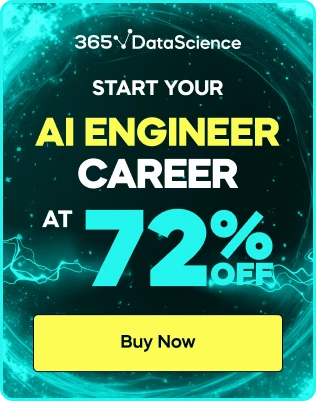We’ve noted that one of the top AI trends for 2025 is multimodal AI.
Multimodal AI refers to a type of machine learning that can handle various forms of data, including images, text, videos, audio, speech, and numerical datasets.
Part of this trend is the growing ability for AI to analyze images.
We’ve seen this in ChatGPT-4, but also in Meta’s latest Segment Anything Model 2—a model that can select any object from an image or video to enhance video editing.
Computer vision engineers are at the head of this groundbreaking field—making this role not only in high demand but also interesting and fulfilling. But navigating the landscape of computer vision engineering can be challenging.
This guide provides insight into common computer vision interview questions, aiming to prepare you for success in this role.
Want to Practice These Interview Questions Live?
Try our AI-powered interview simulator! Customize your interview experience by selecting:
- Your target role
- Dream company
- Interview type (HR or Technical)
- Your background and experience level
Get instant feedback and a detailed score report after each practice session. Take your interview prep to the next level!
Table of Contents
What Does a Computer Vision Engineer Do?
What Does a Computer Vision Engineer Interview Look Like?
Top 10 Computer Vision Interview Questions
Question 2: How do you handle varying lighting conditions in computer vision projects?
Question 3: What are some common techniques for object detection in images?
Question 4: How do you approach image segmentation, and what are some applications?
Question 5: Can you discuss the role of transfer learning in computer vision?
Question 6: What are the challenges in deploying computer vision models on edge devices?
Question 7: How do you evaluate the performance of a computer vision model?
Question 8: What is data augmentation, and why is it important?
Question 9: How do you handle occlusion in object detection tasks?
Question 10: Can you explain the role of generative adversarial networks (GANs) in computer vision?
Become a Computer Vision Engineer with 365 Data Science
What Does a Computer Vision Engineer Do?
Computer Vision Engineers specialize in developing systems that interpret and process visual data, such as images and videos.
They work on designing algorithms that enable machines to understand and make decisions based on visual inputs.
This role needs in-depth knowledge of image processing techniques, machine learning, and neural networks.
Computer vision engineers:
- Develop and optimize computer vision algorithms;
- Implement deep learning models for image and video analysis;
- Enhance image quality and extract meaningful information;
- Collaborate with cross-functional teams to integrate vision systems into larger applications.
What Does a Computer Vision Engineer Interview Look Like?
A computer vision engineer interview typically comprises several stages to assess both technical and soft skills.
Expect questions that test your understanding of fundamental concepts, problem-solving abilities, and practical experience. The types of stages may include the following:
- Technical Screening: Initial phone or video interview focusing on basic knowledge of computer vision and related technologies.
- Coding Challenge: Practical tasks to assess your coding skills, often involving image processing tasks.
- In-Depth Technical Interview: Detailed questions on technologies, algorithms, and your previous project experience.
- Behavioral Interview: Assessment of your soft skills, such as teamwork, communication, and problem-solving abilities.
Below are 10 common AI interview questions and answers for computer vision engineers, focusing on technical aspects and challenges specific to this role.
Top 10 Computer Vision Interview Questions
Question 1: Can you explain the concept of convolutional neural networks (CNNs) and their importance in computer vision?
How to Answer: To tackle CNN interview questions, start by explaining the basic architecture of CNNs, including convolutional, pooling, and fully connected layers.
Describe how these layers help in automatically learning spatial hierarchies from images.
Emphasize CNNs’ capability to handle complex patterns and features, making them relevant in tasks such as image classification and object detection.
Example Answer: "Convolutional Neural Networks are a class of deep neural networks specifically designed for processing structured grid data, such as images.
They are characterized by their use of convolutional layers, which apply a set of filters to the input data to extract and detect patterns.
The main advantage of these layers is that they can be applied directly onto a matrix, thus conserving the spatial structure of the image.
Pooling layers down-sample the data, reducing dimensionality and computational load while retaining important features.
Fully connected layers at the end of the network handle classification based on the extracted features.
This structure allows CNNs to efficiently perform tasks like image classification and object detection by automatically learning complex features from the data."
Question 2: How do you handle varying lighting conditions in computer vision projects?
How to Answer: This is an AI interview question meant to test your technical problem-solving abilities.
Start by discussing the challenges posed by variations in lighting.
Explain techniques like histogram equalization to enhance contrast, and data augmentation methods that mimic different lighting scenarios.
Mention using color spaces like HSV to separate color information from intensity, which helps maintain consistent feature extraction across varying conditions.
Example Answer: "Varying lighting conditions can significantly affect image processing.
To mitigate this, I use histogram equalization to enhance contrast and apply data augmentation techniques, such as adjusting brightness and contrast, to simulate different lighting conditions.
Additionally, using the HSV color space helps separate chromatic information from intensity, ensuring consistent feature extraction and improving the model's robustness."
Question 3: What are some common techniques for object detection in images?
How to Answer: Object detection frequently appears in computer vision engineer interview questions as it's vital for applications like autonomous vehicles and surveillance.
This question showcases your skills in computer vision and real-time processing.
Outline the different methods like sliding window techniques, R-CNNs, and YOLO.
Highlight the advantages and drawbacks of each, particularly in terms of accuracy, computational cost, and speed.
Finally, emphasize how techniques like YOLO are well-suited for real-time applications due to their efficiency.
Example Answer: "Common object detection techniques include sliding window approaches, R-CNNs, and YOLO.
R-CNNs offer high accuracy by generating region proposals and classifying them, but they require substantial computational resources.
YOLO (You Only Look Once) processes the entire image in one pass, predicting bounding boxes and class probabilities simultaneously, which makes it ideal for real-time applications due to its balance of speed and accuracy."
Question 4: How do you approach image segmentation, and what are some applications?
How to Answer: Image segmentation is often highlighted in computer vision questions for its use in many AI applications, where precise pixel-level classification is crucial.
Explain using Fully Convolutional Networks (FCNs) and U-Net architectures.
Discuss how these techniques are crucial in fields like medical imaging, where precise segmentation can aid in diagnosing conditions, and in autonomous vehicles, where it helps differentiate between various road elements and objects.
Example Answer: "Image segmentation involves dividing an image into distinct regions, each identified at the pixel level.
Techniques like FCNs and U-Net are particularly effective in this domain.
In medical imaging, segmentation helps identify and delineate tumors accurately, while in autonomous vehicles, it assists in understanding the environment by differentiating between various road elements, pedestrians, and other vehicles."
Question 5: Can you discuss the role of transfer learning in computer vision?
How to Answer: In computer vision interview questions about transfer learning, highlight the use of pre-trained models such as VGG, ResNet, and Inception.
These models, initially trained on large datasets like ImageNet, can be fine-tuned for specific tasks, which is particularly useful when data is limited.
Explain how transfer learning not only speeds up the training process but also enhances performance by leveraging pre-existing feature hierarchies.
Example Answer: "Transfer learning leverages pre-trained models like VGG, ResNet, and Inception, which have been trained on large datasets such as ImageNet.
This method is especially useful when data is scarce, as these models have already learned to recognize a wide range of features.
By fine-tuning these models for specific tasks, we can achieve high accuracy with limited data and significantly reduce the training time required."
Question 6: What are the challenges in deploying computer vision models on edge devices?
How to Answer: Edge devices are commonly discussed in computer vision job interviews due to their role in enabling real-time processing with limited computational resources, crucial for applications like IoT and mobile computing.
Discuss the challenges such as limited computational power and memory.
Explain optimization techniques like model quantization, which reduces the size and precision of the model, and pruning, which eliminates less critical weights.
Mention frameworks like TensorFlow Lite and NVIDIA TensorRT that assist in optimizing models for efficient deployment on edge devices.
Note that TensorFlow interview questions will likely be common in your job search.
Example Answer: "Deploying computer vision models on edge devices presents challenges like limited computational power and memory.
To optimize for these constraints, I use model quantization to reduce the model's size and precision, and pruning to remove less important weights.
Tools like TensorFlow Lite and NVIDIA TensorRT further optimize the model, making it suitable for real-time applications on devices with restricted resources."
Question 7: How do you evaluate the performance of a computer vision model?
How to Answer: Evaluation will often come up in computer vision job interviews because constant monitoring and updating are crucial for maintaining models’ precision.
Describe the use of metrics such as accuracy, Intersection over Union (IoU), and Mean Average Precision (mAP).
These metrics are crucial for assessing the model's ability to correctly identify and localize objects, providing a comprehensive overview of its effectiveness and areas for improvement.
Example Answer: "Evaluating a computer vision model involves several metrics, including accuracy for classification tasks, IoU for assessing the overlap in object detection, and mAP for evaluating precision and recall across different classes.
These metrics are essential for understanding the model's performance, highlighting its strengths and identifying areas that may require further improvement."
Question 8: What is data augmentation, and why is it important?
How to Answer: For AI interview questions on data augmentation, define the technique and its significance in expanding training datasets.
Discuss methods like flipping, rotation, and scaling, and how they help in preventing overfitting.
By exposing the model to a wider range of scenarios, data augmentation enhances its generalization capabilities, ensuring better performance on new, unseen data.
Example Answer: "Data augmentation is a technique used to artificially expand the training dataset by applying transformations such as flipping, rotation, and scaling to images.
This process helps prevent overfitting by exposing the model to a broad variety of scenarios, thereby improving its ability to generalize to new data.
This is especially useful when the available data is limited, as it enhances the model's robustness and performance."
Question 9: How do you handle occlusion in object detection tasks?
How to Answer: Occlusion is a key topic for computer vision engineers because it challenges a candidate's ability to handle complex visual scenarios.
Discuss how occlusion complicates object detection by hiding parts of objects.
Explain methods such as using robust feature descriptors—which can recognize objects even when partially visible—multi-scale detection to capture objects of different sizes, and ensemble techniques to combine predictions from multiple models—improving overall detection accuracy.
Example Answer: "Occlusion in object detection can make it challenging to identify objects when parts are hidden.
To address this, I use robust feature descriptors that can recognize objects even when only partially visible. Multi-scale detection techniques help by detecting objects at various sizes.
Additionally, ensemble methods, which combine predictions from multiple models, improve accuracy and robustness—making the detection system more reliable."
Question 10: Can you explain the role of generative adversarial networks (GANs) in computer vision?
How to Answer: For generative AI computer vision questions, describe the architecture of GANs, consisting of a generator and a discriminator.
Explain their application in image generation, super-resolution, and data augmentation.
Highlight the importance of GANs in producing realistic images and how they are utilized in various fields, including media and healthcare.
Example Answer: "Generative Adversarial Networks consist of two main components: a generator that creates synthetic images and a discriminator that evaluates their authenticity.
GANs are widely used in computer vision for tasks like image generation, where they can generate new high-quality images, or upscale and clean noisy images, which enhances clarity.
They are particularly valuable in industries like media for creating realistic graphics and healthcare for generating synthetic medical images for training models."
Job Interview Tips
Preparing for a computer vision engineer interview requires both technical knowledge and soft skills. Here are some tips to help you succeed:
Understand the Basics
Ensure you have a strong grasp of fundamental concepts in computer vision, machine learning, and neural networks.
But don’t forget your foundational AI knowledge, as this is equally fair-game in an interview as computer vision-specific skills.
Check out our other articles covering interview questions for other AI roles to be sure you have your bases covered.
Practice Coding
Be proficient in programming languages commonly used in computer vision, such as Python and libraries like OpenCV and TensorFlow.
While this may seem like a no-brainer, you’d be surprised how many people find themselves forgetting their basics after years in a specific role.
For a refresher or to get started on these skills, check out our Python and SQL courses.
Stay Updated
Keep up with the latest advancements in computer vision technologies and techniques.
This role is challenging and demands extensive research into others’ innovations and ideas.
Employers want to know that you’re not just applying for a day job, but are genuinely interested in the field and dedicated to delivering the most up-to-date technologies.
Prepare Examples
Be ready to discuss your previous projects, challenges faced, and how you overcame them.
We always recommend creating a readable, comprehensive portfolio to complement your resume. This shouldn’t just be a list of projects, but thorough explanations that include:
- The problem you’re trying to solve;
- Your planning process;
- The steps you took;
- Any challenges you faced and how you combatted them;
- And the outcome.
This way, employers get an idea of how you tackle challenges in the real world, and whether you fit in well with their company’s work culture.
If you haven’t started any projects yet or are looking to fill your portfolio, 365 Data Science offers you a way to begin without intensive research and finding datasets.
Visit our website to explore a range of ready-made projects—some you can complete for free.
Our projects span various topics and technologies and cater to all skill levels, so you'll easily find something that matches your needs and interests.
Soft Skills
Demonstrate your ability to work in a team, communicate effectively, and solve problems creatively.
Many people overlook that when you join a company, you're not isolated and completing tasks on your own; you become part of a broader network of employees and stakeholders.
This means you need to function effectively both independently and as part of a team—requiring strong communication and teamwork skills.
This communication also extends to presenting your work to both technical and non-technical stakeholders.
This can be challenging for those unaccustomed to explaining complex concepts in simple, understandable terms.
Practice by explaining your projects to friends and family with no background in data or AI, to see if you can communicate clearly enough for them to understand.
Become a Computer Vision Engineer with 365 Data Science
Successfully answering computer vision interview questions requires a blend of technical knowledge, practical experience, and effective communication skills.
By understanding the common questions and preparing thoughtful responses, you can confidently showcase your expertise and stand out in the field.
365 Data Science is here to support you as you break into your career as a computer vision engineer.
Our curriculum covers essential topics, from fundamental programming skills to advanced machine learning algorithms.
By enrolling in our program, you will gain:
- Expert Knowledge: Learn from industry professionals with practical experience.
- Hands-On Projects: Work on real-world projects that enhance your portfolio.
- Certification: Obtain a certification that validates your skills and knowledge.
- Career Support: Benefit from career guidance and support to help you land your dream job.
Check out the following courses from 365 Data Science. They provide you with a comprehensive understanding and skill set in computer vision, from foundational concepts to advanced applications:
- Convolutional Neural Networks with TensorFlow in Python
- Master the intricacies of CNNs, crucial for image classification and object detection tasks, and get ready to answer those CNN interview questions.
- Deep Learning with TensorFlow 2
- Prepare for TensorFlow interview questions and gain a deep understanding of neural networks and their applications in computer vision.
- Machine Learning in Python
- Build a strong foundation in machine learning—essential for computer vision tasks.
- The Complete Data Visualization Course with Python, R, Tableau, and Excel
- Understand how to visualize data, which is important for interpreting the outputs of computer vision models.
- Statistics
- Build a solid foundation in statistics, which is critical for understanding and developing computer vision algorithms.
Once you have developed these skills, come back to these computer vision interview questions to prepare for your dream career.
Good luck!
FAQs








